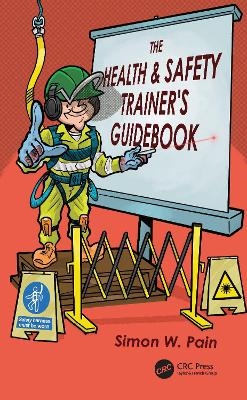
The Health and Safety Trainer’s Guidebook
CRC Press (Verlag)
978-1-032-31242-2 (ISBN)
The text comprehensively explains the effect of the brain on learning and then develops the training processes from training needs analysis all the way through effective training techniques and ending with competence assurance. The unique approach of the book is that Part II provides a range of 30 tried and tested original resource ideas to make health and safety training effective and memorable. It will be a valuable text for professionals and graduate students in the fields of ergonomics, human factors, and occupation health and safety.
Provides practical and tested solutions to common training problems
Covers a resource section showing how to develop interesting and relevant training exercises
Focuses on special needs of health and safety training
Guides the reader through identifying the training need, delivering the training and finally assuring competence
Designed to help trainers design and deliver health and safety training in a fun and high-impact way
Simon W. Pain is a retired multi-award-winning independent Safety, Health & Environmental Management consultant based in Scotland. He has a wealth of health, safety and environmental management experience in various manufacturing industries gained over the last 50 years. A Chartered Mechanical engineer, with over 32 years of experience in senior management positions with British Steel, ICI and DuPont's engineering, manufacturing, research and corporate functions. He has been advising company executives at the board level on Safety, Health & Management issues for the last 25 years. He spent many years as Divisional Safety, Health & Environmental Manager for ICI and Dupont, the latter being widely regarded as the world benchmark company for health & safety standards. During the last 20 years he has developed novel techniques in Health & Safety training & communication which have have been commended by the Institute of Occupational Safety & Health in November 2004. As a consultant, Simon Pain specialized in raising awareness and motivating senior managers to achieve a paradigm shift in health & safety awareness. He did this by using the high impact approach and making the subject interesting and fun. He is an expert in auditing, especially at the management level and personally designed and developed the ICI audit protocol system to ensure that auditing standards were consistent. As a DNV trained auditor he has led audits not only in the UK, but also in the USA, India, Japan, Malaysia, Belgium, Germany, Spain and the Netherlands. He has extensive experience of lecturing and training in all aspects of health, safety and environmental management. He is a Fellow of both the UK’s Institution of Mechanical Engineers and the Energy Institute and a Chartered member of the Institute of Occupational Safety & Health. He was also a member of the UK Government’s Energy Best Practice Committee and a Board Member for the Solway River Purification Board until the formation of the new Scottish Environment Protection Agency. Simon graduated in Mechanical Engineering from the University of Birmingham and earned his postgraduate qualifications in Health & Safety from the University of Loughborough. He is the author of 2 international books on Safety, Health & Environmental auditing, published by CRC Press / Taylor & Francis and has received 7 industry awards over the last 5 years, including International Consultancy of the Year in 2017 and 2021.
PART I
1 INTRODUCTION
2 THE IMPORTANCE OF MEMORY TO LEARNING – How adults learn
2.1. Short-term & Long-term memory
2.2. Repeat, Recap & Review
2.3. Other Memory techniques – Mnemonics and Acronyms.
2.4. Get in the Cue
2.5. Memory Techniques
3 COMMUNICATION – Getting the message across
3.1 Verbal Communication
3.2 Active listening
3.3 Visual Communication
3.4 Written Communication
4 THE AUDIENCE – Who will be there?
4.1. Types of trainees
4.2. Large audiences
4.3. Training Room Layouts & Numbers of trainees
4.3.1. Board Room Layout
4.3.2. U- Shape or Horseshoe layout
4.3.3. V-Shape layout
4.3.4. Cafe Style layout
4.3.5. Theatre Style layout
4.4. Where should training be done?
5 TRAINING NEEDS – Who needs to know what?
5.1. Identifying Training Needs
5.2. Knowledge Checks
5.3. Training levels
5.4. Records
6. DESIGNING THE TRAINING – What do they need to know?
6.1. Session Specifications
6.2. Sacrificial Content
7 TRAINING STYLES & TECHNIQUES - Making the training interesting
7.1. What type of training is appropriate?
7.2. Videos as a training aid
7.2.1. Commercial videos
7.2.2. Bespoke videos
7.3. Models
7.4. Posters and chart boards
7.5. Sticky note displays
7.6. Real life experience
7.7. Simulations
7.8. Role Plays
7.9. Photographs
7.9.1. Photographs in Work Instructions & Training manuals
7.9.2. Photographs as Posters
7.9.3. Photographs in safety training presentations
7.9.4. Photographs used in training exercises
7.9.5. Photo hazard spotting exercises
7.9.6. Photographic hazards spotting (Camera Hunt)
7.10. Jigsaws
7.11. Using Flip Charts
7.12. Drawings, & wallcharts
7.13. Props and Gizmos
7.14. Exhibits & displays as an aid to training
7.15. Webinars
8 PREPARING COMPUTER DISPLAYED VISUAL IMAGES – What you see is what you get!
8.1. PowerPoint presentations
8.2. Too many slides
8.3. Important Tip
8.4. Animation
8.5. Media transfers
9 HANDOUTS & SUPPORTING MATERIALS – Providing supporting material
9.1. Remove text that you will use for interactive questions
9.2. Remove all the background graphics
9.3. Making changes
9.4. Handouts for international audiences
9.5. Professionally printed handouts
9.6. Using handouts during a presentation
9.7. Bookmark handouts
9.8. Ponder Sheets
10 THE ART OF PRESENTATION DELIVERY – Getting your message across.
10.1. Giving a performance
10.2. The Difference between Data & Information
10.3. Address trainees by name
10.4. Dress Code
10.5. Mannerisms
10.6. Enthusiasm
10.7. Engagement
10.8. Setting the Scene
10.9. Promoting discussion
10.10. Tempo
10.11. Public Speaking
10.12. Attention Span
10.13. Emphasis
10.14. Use of pointers, lasers and presenters
10.15. Pilot Events
10.16. When things go wrong
11 RUNNING EXERCISES & ACTIVITIES – Making it fun!
11.1 How to plan the exercise
12 VALIDATION & COMPETENCE – Checking that they have understood.
12.1. Validation
12.2. Mentoring & the road to competence
13 TRAINING ADMINISTRATION
13.1. Pre-Course information
13.2. Equipment lists & trainers kits
13.3. Stationary box
14 EVALUATING TRAINING – Did it work?
14.1. The 4 levels of training assessment
15 TRAINER SELECTION - Select Leaders who will inspire!
15.1. Who should do the training?
15.2. Presenter / Trainer deputies
16 TRAIN THE TRAINER
16.1. Train the Trainer materials
16.2. Trainer skill training
PART II - TRAINING RESOURCES SECTION
PURPOSE - Using the resources section
Training activities & Exercises:
A) Jigsaws
B) Photohazard spotting
C) Camera Hunts
D) Bespoke Videos & DVDs
E) Flash Cards
F) Gizmos
a. Consequences Game
G) Interactive Exercises
H) Games
a. Solway Risk Game
b. Happy Human Factors
c. Hierarchy of Controls Magnetic Darts
I) Role Plays
a. Excalibur Supplies Exercise
J) Event Case Study (Lochside Engineering Ltd)
K) Emergency Simulation
L) Competitions
M) Quizzes
N) Puzzles (Communications exercise)
O) Mock Scenarios
a. Safe Systems of Work
b. Confined Space Entry
c. Working at Heights
P) Personal Protective Equipment Exercise
Q) Noise Simulation Exercise
R) Manual Handling Assessment Exercise
S) Crosswords & Piecewords
T) Personal Commitment Statement
U) Hazard Recognition
V) Co-incidence or not?
W) Unfamiliar Task Assessment slide rule
X) Microbooks
Y) Circle the Hazards
| Erscheinungsdatum | 10.11.2022 |
|---|---|
| Zusatzinfo | 39 Line drawings, black and white; 73 Halftones, black and white; 8 Illustrations, color; 104 Illustrations, black and white |
| Verlagsort | London |
| Sprache | englisch |
| Maße | 156 x 234 mm |
| Gewicht | 594 g |
| Themenwelt | Geisteswissenschaften ► Psychologie ► Allgemeine Psychologie |
| Naturwissenschaften ► Biologie ► Zoologie | |
| Naturwissenschaften ► Chemie ► Technische Chemie | |
| Technik ► Umwelttechnik / Biotechnologie | |
| Wirtschaft ► Betriebswirtschaft / Management ► Personalwesen | |
| ISBN-10 | 1-032-31242-4 / 1032312424 |
| ISBN-13 | 978-1-032-31242-2 / 9781032312422 |
| Zustand | Neuware |
| Informationen gemäß Produktsicherheitsverordnung (GPSR) | |
| Haben Sie eine Frage zum Produkt? |
aus dem Bereich


